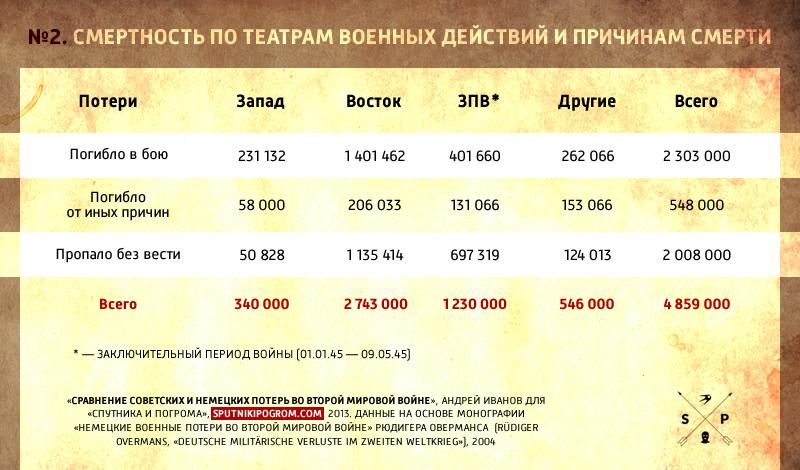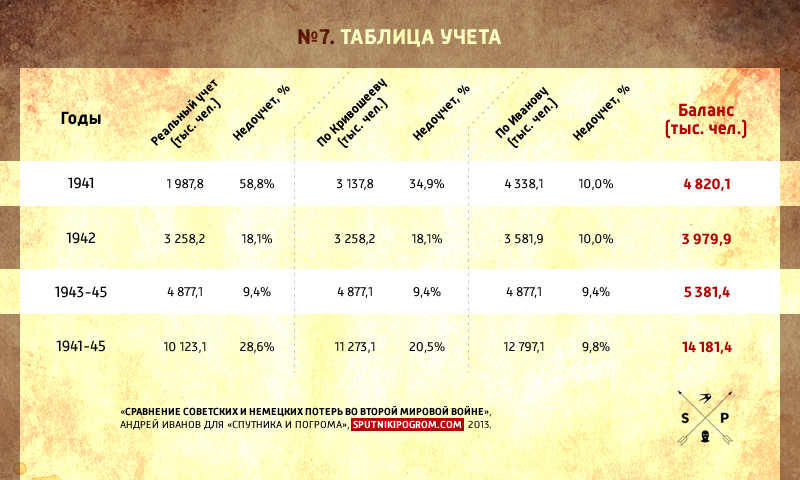Friends, our regular contributor Andrey Ivanov wrote a huge material on comparing the losses of Germany and the USSR, full of detailed calculations and links to data sources, in fact - a full-fledged study for an academic journal. Those of you who do not distinguish Krivosheev from Overmans and are not interested in the problem of calculating losses in World War II can skip straight to the end of the material, IV and V parts, in which you can find the final figures and the answer to the question "So did the Soviet Union fill up the Germans with corpses or not?" More advanced readers are encouraged to read the entire material.
We also hope that this material will be used as an understandable reference for everyone who wants to discuss the Second World War.
There are many comparisons of Soviet and German losses, but I have not yet met an impeccable job even among the works of very competent people. This article is not such either, but at least it is the most complete one I have seen and, I dare to hope, is methodologically completely correct (the dispute can be about nuances and details, but not about the general approach I have chosen).
So, let's begin. Especially for "Sputnik and Pogrom"!
I. Terms and concepts
First of all, for a correct comparison, you need to know and understand many details, clearly understand the origin and meaning of the compared figures, because otherwise - by intent or banal ignorance - you will get a comparison of warm with soft.
The most important thing to understand is the presence three different methods of calculating losses, which have different accuracy:
Named method(in common parlance - "name" or "card index") - a method of calculating losses, based on the presence of a name card index. In fact, the "database" of losses. The advantages of the method include its extreme detail and completeness. The disadvantages are the extreme laboriousness in drawing up the card index and the tendency to overestimate losses due to duplicate cards.
Balance method(in common parlance - "balance") - a method of calculating losses, which compares the list numbers of the formations of interest before and after an event (plus marching reinforcements for this period, minus different types of attrition for this period). The advantages of the method include a higher accuracy than that of the accounting-statistical method (it is believed that it still underestimates real losses, but quite a bit). The disadvantages - as a rule, it is possible to count only for certain and rather large periods (the whole war, less often - certain years of the war, very rarely - individual battles or operations), plus the balance method does not allow differentiating some losses from others.
Accounting and statistical method(in common parlance - "accounting") - a method of calculating losses, in which the losses of military formations are systematically calculated by their headquarters. The reports of the lower headquarters are summarized in the higher ones. It includes the dead and dead, missing and captured, wounded and sick, evacuated to medical institutions, convicts, deserters, etc. for any period, battle, formation). The disadvantage is that this method tends to greatly underestimate losses. For example, in the Soviet-Finnish war, the underestimation of accounting was about 30%, against the roll-call method of calculation. If we compare the accuracy of the Soviet accounting in the last years of the Second World War with the balance sheet, then the accounting-statistical method underestimated about 10% of losses (see below).
We get the following ratio: File cabinet> Real losses> Balance> Accounting
In addition to various types of accounting, there are also different categories of losses. For example, losses are divided into irrecoverable and returnable (sanitary) losses:
Irrecoverable losses- dead and dead, missing and taken prisoner.
Sanitary losses- wounded, shell-shocked, sick and frostbitten military personnel who have lost their combat effectiveness and evacuated from the area of hostilities to medical institutions for at least one day.
Irrecoverable losses in turn are subdivided into:
Combat- these are those killed on the battlefield, who died from wounds during the stages of sanitary evacuation and in hospitals, who disappeared in battle and were taken prisoner.
Non-combat- losses not related to the direct execution of a combat mission, including in the troops conducting hostilities (those who died during careless handling of weapons, in accidents, disasters and as a result of other incidents, who died from illness in medical institutions (at home), who finished life by suicide, executed by military tribunals for various military and criminal offenses).
In addition, they allocate demographic losses of the Armed Forces.
Demographic losses of the Armed Forces- these are the dead and dead servicemen and civilians who were in the army and navy, regardless of the causes of death (death), as well as those who did not return from captivity, that is, people who were irretrievably lost both for the army and for the country.
As you can see, there are many categories of losses, and the presence of three methods of accounting for losses increases it even more. Therefore, the question arises, which category (and accounting method) should you still choose for comparison? Since the main purpose of such comparisons is most often to compare the ability of armies to fight, I usually take for comparison the category of irrecoverable losses (usually, for lack of a better, calculated by the accounting and statistical method), which, in my opinion, most adequately reflects the ability of armies to fight - after all, planning and it is much more difficult to carry out an encirclement operation than to “push” the enemy frontally from their positions. On the other hand, the use of irrecoverable operational losses excludes speculation on the topic of those killed in captivity (and there the spread of figures, for example, for Soviet prisoners of war in several million).
It would be even better, of course, to compare the irrecoverable combat losses, but for the Second World War this presents a certain difficulty. And even with this approach, the influence of the brutal Soviet methods of maintaining discipline will be leveled.
Also, for comparison, you can use demographic losses, although speculation on the topic of those killed in captivity, etc., is possible. “Bloody losses” (killed and wounded in the course of hostilities).
II. Named method (card index)
a) USSR
The most famous card index today, or rather the card index of Soviet losses, is the TsAMO card index:
File file of losses of privates and sergeants
- Card index of losses of officers and generals
Accounting first filing cabinet was conducted in the following categories:
1.deceased - according to reports of military units,
2.deceased - according to reports of military registration and enlistment offices,
3. missing persons - according to reports from military units,
4. missing persons - according to reports of military registration and enlistment offices,
5.deceased in German captivity,
6.deceased from disease,
7.deceased from wounds - according to reports of military units,
8. deaths from wounds - according to reports of military registration and enlistment offices.
In addition, all sorts of deserters were taken into account, sentenced to imprisonment in a labor camp, sentenced to military service, who were on suspicion that they had served with the Germans ("signal"), etc. However, these soldiers and sergeants were not included in the list of irrecoverable losses.
As of November 1, 2000, 20 letters of the alphabet were processed, and a preliminary calculation was made for the remaining 6 uncounted letters, with fluctuations up or down by 30-40 thousand persons. Calculated 20 letters in 8 categories of losses of privates and sergeants of the Red Army gave the following figures: 9,524,398 people. At the same time, 116,513 people were removed from the register of irrecoverable losses, as they turned out to be alive according to reports from military enlistment offices. A preliminary calculation of 6 uncounted letters gave 2,910,000 irrecoverable losses. The result of the calculations was as follows: 12 434 398 Red Army men and sergeants were lost by the Red Army in 1941-1945.
In the amount of 1 million 100 thousand people in the officer's card index, we receive losses of the People's Commissariat of Defense in 13 534 398 people. Further, some people (for example, the same Ilyenkov) add to this figure 155 thousand losses of the Navy, 98 thousand losses of the NKVD Internal Troops, 61 thousand losses of the NKVD Military District, and receive a total of 13 850 000 demographic losses of the USSR Armed Forces.
Different methods of calculating losses are mixed here: by name and accounting and statistical. And as mentioned earlier, accounting can underestimate up to a third of losses against the card index, even in a relatively calm atmosphere of the Soviet-Finnish war. Of course, the "card index" of the Navy and the NKVD in the form of ~ 100 thousand people. looks ridiculous against the background of 13.5 million losses of the People's Commissariat of Defense, but nevertheless it is there and must be taken into account.
To complete the picture, it would be nice to add the partisans, the people's militia, extermination battalions, etc.
The card index (or at least the voiced calculations) does not take into account the “wrong” losses in the Soviet opinion: deserters sentenced to military service and others.
According to the reviews of search engines, the TsAMO card files themselves are extremely incomplete.
b) Third Reich
The most famous German file today is the Deutsche Dienststelle (WASt). At the moment, it has more than 18 million cards of German and foreign soldiers who fought in the Wehrmacht or German paramilitary organizations. Let me emphasize: we are talking about those who fought (and not those who died). However, there is a well-known monograph by Rüdiger Overmans "German military losses in World War II" ( Rüdiger Overmans "Deutsche militärische Verluste im Zweiten Weltkrieg"), which, on the basis of a mathematically reliable sample from this card index, clarified the issue with the victims:




comparing to
Now let's try to compare the given figures correctly. To begin with, we note that allies and satellites were not counted for the Germans (but foreigners who fought as part of German troops or paramilitary formations were counted), and Soviet data on the People's Commissariat of Defense are simply incomplete (in addition, Soviet paramilitary organizations and foreign allies are not taken into account). These are serious shortcomings, but one can hope that they compensate for each other to some extent, while the search and attraction of such figures will increase the complexity of the calculations at times.
The distribution of losses along the fronts in the final period of the war (01.01.45 - 09.05.45) is still unknown, but it can be assumed that the Eastern Front, as before, gave about 70% of German losses.
Finally, it is not clear how to count the losses of the branches of the Armed Forces of the USSR and Germany, because the losses of all German types are known in the form of file data, and the Soviet ones are known only by the People's Commissariat of Defense (army and air force). We know the losses of the People's Commissariat of the Navy, as well as the Internal and Border Troops of the NKVD, only in the form of accounting, therefore, we either need to multiply them by a certain coefficient (which can be disputed) to bring to the "card index", or do not take into account the losses of the Navy / Navy and NKVD / SS in comparison (which can also be disputed). This article uses the second option.
As a result, the demographic losses of Germany on the Eastern Front will amount to 2,471,490 (army) + 166,891 (Air Force) + 28,132 (other organizations) + 363,000 (died in captivity) + 861,000 (Eastern Front in the 45th year) = 3 890 513. Comparing with the Soviet losses of the People's Commissariat of Defense in 13 534 398 people, we get that:
The demographic losses of Germany and the USSR, calculated by the card index method, are 1: 3.5.
III. Balance
a) USSR
There are two known Soviet balances: the official balance of G.F.Krivosheev, and the balance of S.N. Mikhalev and his student A.V. Tolmacheva. At the same time, the first is, in principle, incorrect (as can be seen from the book of Krivosheev itself), and the advantage of the second, in addition to correctness, is the presence of separate balances for the 41st and 42nd years (it will be useful for us to find the next mistakes of Krivosheev, but already when calculating method).
The main lie in the Krivosheevsky balance is due to the re-called, which he subtracts twice. In principle, this was known before (from the works of S.N. Mikhalev), but in the new edition of his book Krivosheev made it easier for us to find errors in him and for the first time described in detail the composition of the re-called:
This number includes 2,237,300 people. was called twice during the war, of which:
939.7 thousand of the servicemen who disappeared without a trace at the beginning of the war, and after the liberation of the territory seized by the enemy were called up again;
- 1154.8 thousand people from the number of persons dismissed on long leave for injury and illness;
- 142.8 thousand people from among those liable for military service, previously called up and sent to work in industry and transport.
I will show it in tabular form:

You can simply subtract from the corresponding graphs the numbers of the re-called, but in order not to get confused, it is better to add ALL re-called to the mobilized ones, and then subtract the Krivosheyev figures - we getsecond column. Orange I highlighted the numbers, which include all 2,237.3 thousand re-called (939.7 + 1,154.8 + 142.8). When we subtract from them the uncorrected Krivosheevsky commissioned and demobilized, the last two terms of the entire sum of those recruited are reset to zero, and we get a remainder containing only 939.7 thousand recruited in the occupied territories - highlightedgreen . Left column- this is according to Krivosheev (with the correction of re-called). Red I highlighted the numbers where he lied: as follows from the above quote, there were actually not 3 798.2 thousand people who were commissioned due to illness, but 1 154.8 thousand people. less - 2 643.4 thousand people. The demobilized were not 3 614.6 thousand people, but 142.8 thousand people. less, that is, 3 471.8 thousand people.
But if we are interested in demographic losses, then, in addition to 1,836.6 thousand returned from captivity, we must subtract 939.7 thousand re-conscripted. It turns out - 11 405.1 thous.
This is if you do not go into details. Because, for example, not all prisoners of war were released after the war, liberation took place during it, and some of these prisoners of war were drafted into the army. Consequently, in order to obtain demographic losses from the operational ones, it is necessary to deduct not 1,836.6 people, but less - about 950 thousand. They were transferred not only to the NKVD, but also from the NKVD. And so on and so forth. In general, Krivosheev's calculations can be improved and improved, but I will focus on the semi-official figure of 11,405.1 thousand.
To summarize:
Irrecoverable operational losses of the USSR Armed Forces (calculated using the balance method) - 14,181.4 thous.
- Irrecoverable demographic losses of the USSR Armed Forces (calculated by the balance method) - 11,405.1 thousand.
b) Third Reich
Due to the collapse of management, the Germans have no complete (for the entire war) balance, but you can calculate the partial balance on December 1, 1944. All the necessary figures can be found in the "German Land Army, 1939-1945." Müller-Hillebrand:

comparing to
NB: It is NOT POSSIBLE to reliably compare the Soviet and German balance sheets.
If we know exactly the Soviet balance, then the German one is known only for the period from 01.06.39 to 1.12.44, in addition, the distribution of German losses along the fronts is unknown. The balance is presented to demonstrate the fact that not everything and not always can be counted, and also to make it difficult to mix different types of accounting - for example, some compare the German card index (according to Overmans) with the Soviet balance, which is methodologically wrong.
IV. Accounting
a) USSR
Today, one work is known that analyzes Soviet accounting during the Second World War - this is the work of G.F. Krivosheev (although, to be absolutely precise, Krivosheev relied on the results of the work of two Soviet commissions to determine losses - the commission of S. M. Shtemenko (1966-1968) and the commission of M. A. Gareev (1988). that the figures for the first years of the war have very little to do with reality. ”As Krivosheev himself writes:
The missing in the first six months of the war, when reports from a significant part of the encircled Soviet troops did not arrive, are referred in the book to the so-called unaccounted for losses. According to the authors' estimates, they amounted to 1162.6 thousand people. and are included in the information on the losses of the respective fronts and armies that did not submit reports.
1162.6 thousand people - this is with border guards, without them - 1150 thousand people. Krivosheev, of course, does not disclose "Author's calculations", but using the balance for the first years of the war, we can assess the accuracy of these calculations:

As you can see, Krivosheev only reduced the underestimation of losses of the USSR Armed Forces in 1941 from 58.8% to 34.9%, and did not touch at all in 42. Hence, it is not surprising that all the amendments to Krivosheev's data that appear in the press are mainly in the 41st and, less often, in the 42nd year.
If we proceed from the fact that the "normal" underestimation of the accounting-statistical method relative to the balance one is approximately equal to the underestimation of 43-45 (ie, around 10%), then a correctly adjusted accounting of the USSR Armed Forces will look like mine.
b) Third Reich
It is more difficult with German accounting. First, there were several channels for supplying information through which, although close, but not identical, information was supplied. Therefore, between the statistics of various services of the Wehrmacht, there are small (and from the second half of 1944, and large) discrepancies. Secondly, as with the balance sheet, there is no more or less complete data for the 45th year. Thirdly, not all German statistics are processed for immediate use.
Because of all of the above, when comparing casualties, I will use the monthly casualty figures from the German Land Army 1933-1945. B. Müller-Hillebrandt - not to say that it is an ideal option, but it is not much inferior to others.
comparing to

Notes:
For the Third Reich, losses of the army and SS troops are considered, but without the fleet and the air force, for the USSR, on the contrary, the losses of the army, navy and air force, but without the air and military forces of the NKVD. Allies and paramilitaries are not counted.
- Quarterly German losses are given on all fronts (not only on the Eastern Front). Before the opening of the second front on June 6, 1944, the Eastern Front gave 90 +% losses, with the exception of the second quarter of the 43rd (Tunisia). After - about 70%.
- Soviet data for 41st and 42nd is Krivosheev's officialdom. It should be noted that the real Soviet losses in 41 were 38%, and in 42, 10% more than Krivosheev's figures. On the other hand, from the second half of 1944, the quality of German statistics also began to decline.
In reality, the ratio (taking into account all the above-described nuances) is more or less reliable for the period from the second half of the 42nd to the first half of the 44th, which gives a ratio of 1: 3.5. If we take strictly by years, then only the 43rd year is reliable, which gives the ratio of irrecoverable operational losses approximately as 1: 3 (and the ratio for the 43rd year should not be transferred to the war as a whole).
V. Conclusion
It is difficult to accurately calculate the ratio of losses in WWII. In addition, there are doubts about the meaningfulness of such "gross" comparisons (monthly / quarterly charts can be much clearer and more informative, and it is even better to somehow normalize them in number, because on the eastern front the Soviet group exceeded the German one by an average of 2.5 -3 times). But if, nevertheless, the whole question of the quality of the German and Soviet armies is reduced to one indicator - the ratio of losses - then, in my opinion, of the available figures, the ratio of 1: 3 (+/- tenths) most adequately reflects the situation.
1: 2 is obviously not enough, 1: 4 is a lot, and 1: 3 is just right.
Total: for each German, the Soviet government paid with THREE Russians, which can be called "filled up with corpses."
Happy Victory Day, Soviet.
Rüdiger Overmans "Deutsche militärische Verluste im Zweiten Weltkrieg", 2000
- Krivosheev G.F. “The Great Patriotic War without a stamp of secrecy. Book of losses ", 2010
- Mikhalev S.N. “Human losses in the Great Patriotic War of 1941-1945. (statistical research) ", 2000
- Müller-Gillebrandt B. "The Land Army of Germany, 1933-1945", 2003
- Tolmacheva A.V. "The combat and numerical strength and losses of the armed forces of the opposing sides on the Soviet-German front during the Great Patriotic War: 1941-1945.", 2006
- ww2stats.com
- poteri-sssr.livejournal.com
Links and Notes:
Kurtukov I. "The ratio of losses on the Soviet-German front"
S.I. Golotik, V.V. Minaev "Demographic losses of the USSR in the Great Patriotic War: the history of calculations"
Ilyenkov S.A. "The memory of the millions of fallen defenders of the Fatherland cannot be consigned to oblivion"
forum.vgd.ru - "What, where and how are we looking for in the Central AMO RF?"
G.F. Krivosheev “The Great Patriotic War without a stamp of secrecy. Book of losses. ", M. 2010, p. 37
poteri_sssr - "War and Society 1941-1942". Book 2.M .: Nauka, 2004
poteri_sssr - "Black Infantry" - unaccounted for losses
poteri_sssr - No one is forgotten? And how many of them are “unforgotten”?
Mikhalev S.N. Military Strategy (p. 706)
A.V. Tolmacheva "The combat and numerical strength and losses of the armed forces of the opposing sides on the Soviet-German front during the Great Patriotic War: 1941-1945." (p. 159)
THANK THE AUTHOR
for the calculations and work with sources you can and should use the following details:
Qiwi: 9136136693
PayPal:
Webmoney: R462829315374 / Z012046083568




